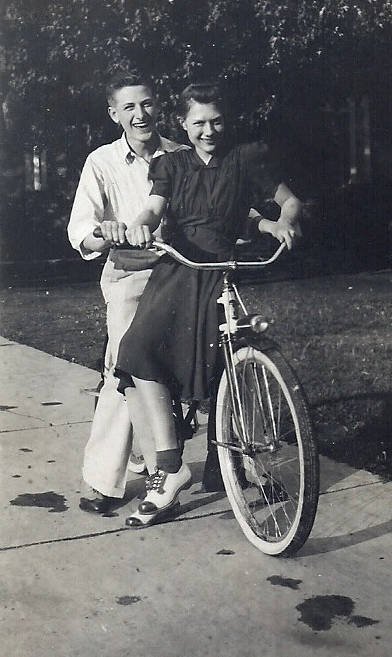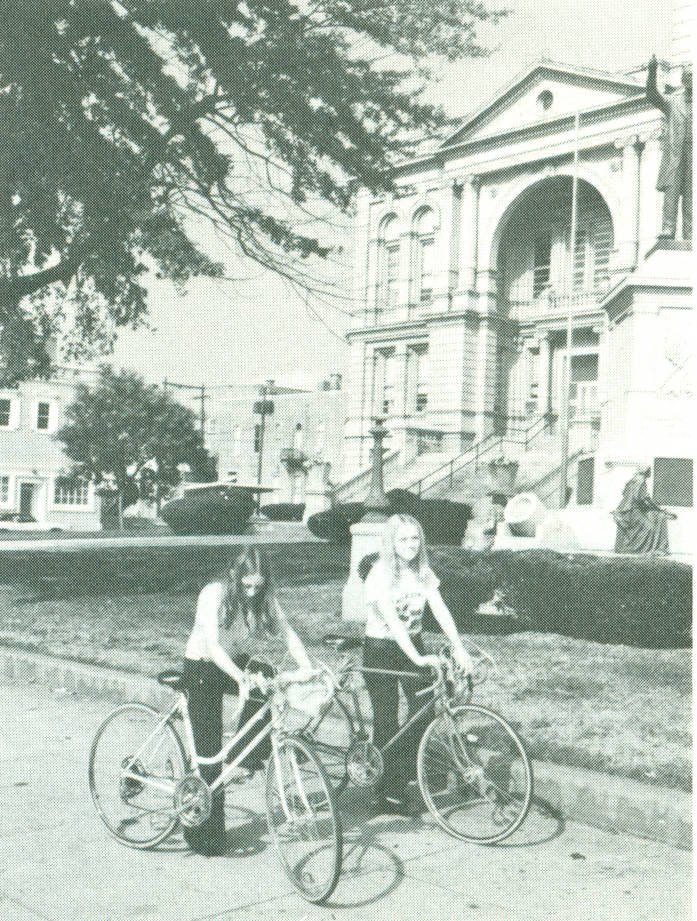by Emily Rinaman, Technical Services Manager
The horse has been completely replaced by the automobile for human travel, but there is one other mode of transportation that has only gained popularity over the decades – the bicycle.
Unicyclists ride down Washington Street during the 1976 Bicentennial Parade in Tiffin.
Just within the past year, Tiffin has officially marked its bicycle routes through town. And over the years it has seen its share of bicycle “parades” that have made a one-day stop in town before continuing on their trek.
During the “Golden Age of Bicycles,” which started in the 1900s and lasted through the 1950s, Tiffin boasted a number of bicycle repair shops and dealers, proving as a testimony of the global hype these new vehicles created.
While Leonardo Da Vinci has been credited has having drawn a blueprint of a bicycle, it never came to fruition until the early 1800s as several men in Germany, England and France all came up with different versions of the bicycle, which developed over time.
Junior Home students Jerri Francis and friend have fun riding a bike around campus in the early 1940s.
The first “hobby horses,” as they were dubbed, were made out of wood. With no pedals, one had to get a running start and then hop onto the contraption. He or she then simply rode it until the momentum slowed. Pretty anticlimactic and really didn’t get anyone anywhere, if they were going to use it as an alternative to a horse (or even simply walking). Then came the “boneshakers” in the 1860s, which had pedals and were made with iron, but were as their name implied – bumpy.
The 1870s saw an explosion of bicycle types, and ones we are more familiar with, notably the large-wheeled bicycles called “penny-farthings” and the first prototypes of the modern-day motorcycle.
Once the bicycle had reached this stage of its development, the bicycle became more widespread and by that point had been introduced to Seneca County.
D.M. Eastman was a dealer of “Giant Bicycles” in his stop at 141 Washington St. where he also sold sewing machines. Just down the street, the A.L. Flack & Co. at 157-161 Washington St. added bicycles to their repertoire of buggies and harnesses, even going so far as to also rent bicycles like we often see today. Later, there would be additional shops at 421 Washington St., 145 Market Street, 118 Melmore and 134 Sycamore.
By the 1890s, bicycle clubs had developed (Fostoria’s was called Fostoria Bicycle Club No. 226). These societies did more than just leisurely travel in groups (much like today’s poker runs for charity). They lobbied for the government to build better infrastructure and safer, paved roads. Today, there are several bicycle clubs in the area including: Toledo Area Bicyclists (Whitehouse), Maumee Valley Adventurers (Toledo), Flatland Bicycle Club (Lindsey), Maumee Valley Wheelman (Bowling Green), Team Roadrunners (Lima), Mid-Ohio Bikers (Mansfield), Heart of Ohio Tailwinds (Marion) and Silver Wheels (Vermillion).
Two girls ride their bikes past the old Seneca County Courthouse building. This photo was produced in the Tiffin Area, Ohio booklet that’s been digitized onto the Seneca County Digital Library. https://ohiomemory.org/digital/collection/p15005coll27/id/25131
At the same time that the Penny-Farthings were appearing, the motorcycle was developing. The first several versions used coal burners and alcohol steam chambers. Then, once a couple of German inventors figured out how to attach a gasoline combustion engine to the frame, the “riding wagon” was on the market.
After that, the motorcycle could be massed produced. Both Webster Industries and National Machinery made parts contributing to the bicycle industry. Among many trades, bicycle manufacturers were one of the customers of Webster. In National Machinery’s 100th Anniversary booklet from 1974, it states over the course of a century, the factory had produced “metal parts that go into almost any mechanical device from a bicycle to a transcontinental jet liner.”
Bicycles also helped employers perform their jobs and business owners effectively run their businesses. The lamplighter in New Riegel in the 1920s, Louis Seifert, was granted permission to ride his bicycle along the street while lighting lamps (probably getting the job done much faster). Ballreich’s Potato Chips owner and founder, Fred Ballreich, used his bicycle to deliver their product to customers.
But what started out as a fun diversion and a practical solution for travel, started to become competitive. In the 1950s, it had become an intramural outdoor sport of the Girls Athletic Association with Columbian High School having a team during the 1953 season. (Further west, today’s high schoolers can participate in bicycling as an official high school sport through the National Interscholastic Cycling Association, founded in 2009).
When the Heritage Festival began in Tiffin in the 1980s, it featured both canoe races and an eight-mile bicycle race. And it’s no secret that this competitiveness has reached a worldwide stage with bicycling and triathalons, which feature a bicycling component in between swimming and running, being Summer Olympic sports. Not to mention, BMX racing for motorcycles (talk about “boneshaking!”)
An experiment that started a few hundred years ago has since evolved into a cultural phenomenon. There’s hardly anyone who will hear the words “Harley-Davidson” and not be able to drum up a picture in their mind of a loud two-wheeled vehicle. Bike racks grace the sides of city buildings, and in larger cities have dozens to rent.
Perfecting the Penny Farthing, though, will always be a feat.
Works cited:
1974 National Machinery 100th Anniversary. Seneca County Digital Library. https://ohiomemory.org/digital/collection/p15005coll27/id/32930
Andrews, Evan. “The Bicycle’s Bumpy History. History Channel. Feb. 18, 2021. https://www.history.com/news/bicycle-history-invention
Bicycle History. “History of Bicycles.” And “History of Motorcycles.” http://www.bicyclehistory.net/motorcycle-history/history-of-motorcycle/
Bures, Frank. “How High School Mountain Biking is Transforming the Sport.” May 3, 2017. https://www.bicycling.com/racing/a20036423/how-high-school-mountain-biking-is-transforming-the-sport/
Fourth Annual Heritage Festival 1982. Seneca County Digital Library. https://ohiomemory.org/digital/collection/p15005coll27/id/27514
History Cooperative. “The History of Bicycles.” July 1, 2019. https://historycooperative.org/the-history-of-bicycles/
Ohio Bicycle Federation. “Ohio’s Bicycle Clubs.” https://ohio.bike/ohios-bicycle-clubs-listed/ Accessed March 7, 2023.
Seneca County Genealogical Society. “Seneca County, Ohio History and Families”. 1998. Seneca County Digital Library. https://ohiomemory.org/digital/collection/p15005coll27/id/28319
Wagner, Elaine. “A History of New Riegel.” Seneca County Digital Library. https://ohiomemory.org/digital/collection/p15005coll27/id/32008
Webster Manufacturing Belt Conveyor Equipment. Seneca County Digital Library. https://ohiomemory.org/digital/collection/p15005coll27/id/38325
Wiggins Directory for 1897-8. Seneca County Digital Library. https://ohiomemory.org/digital/collection/p15005coll27/id/31003
Yearbook Columbian Blue and Gold 1953. Seneca County Digital Library. https://ohiomemory.org/digital/collection/p15005coll27/id/7703



